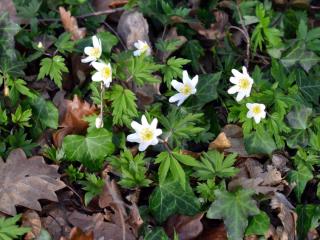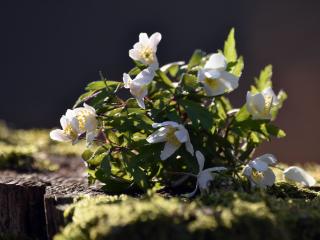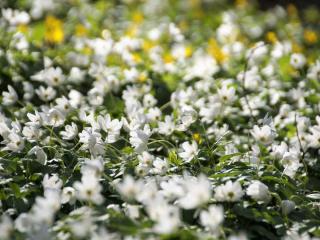

Wood anemone is a short rhizome perennial that bears white flowers in full shade.
Key Anemone nemorosa facts:
Latin name: Anemone nemorosa
Common name: Wood Anemone
Family: Ranunculaceae
Type: Bulbous perennial
Height: 6 to 8 inches (15 to 20 cm)
Planting density: 4 to 6 plants per 10 sq feet (1 m²)
Exposure: shade to part shade
Soil: any type, humus-rich, moist but well-drained
Bloom: Spring – Foliage: Deciduous
Wood Anemone, also known as Anemone nemorosa, stands shorter than its cousins. Its leaves closely resemble those of other anemones. However, its flowers bring their own unique flair with a white hue touched by shades of pink to reddish on the outside.
 Anemone nemorosa isn’t picky about soil type—whether clay, limestone, or sandy. It also tolerates all pH levels. Just make sure soil remains moist without staying waterlogged. As for sunlight, avoid direct rays; they might scorch the delicate leaves. Shade or part shade works best.
Anemone nemorosa isn’t picky about soil type—whether clay, limestone, or sandy. It also tolerates all pH levels. Just make sure soil remains moist without staying waterlogged. As for sunlight, avoid direct rays; they might scorch the delicate leaves. Shade or part shade works best.
Planting in fall sets your Wood Anemone up nicely for warmer seasons. Spring planting is doable, but you’ll need to be more careful and not forget watering that first summer.
Planting is easy:
Think of placing around 5 plants for every 10 sq feet (1 m²) or so of space.
 Feel like planting your wood anemone in a pot? Get a pot that can store water at the bottom. Ensure there’s a drainage layer at the base but don’t block water: it should be able to escape.
Feel like planting your wood anemone in a pot? Get a pot that can store water at the bottom. Ensure there’s a drainage layer at the base but don’t block water: it should be able to escape.
To keep soil moisture high in all seasons, a thick layer of mulch after planting is recommended. It’ll double as frost protection for your wood anemone during winter.
 Anemone nemorosa is almost maintenance-free.
Anemone nemorosa is almost maintenance-free.
Just ensure soil stays moist. But watch your watering frequency:
In late winter, trim back the plant to allow new foliage to emerge.
While this wild anemone can spread through seeding, the quickest and most effective method is still dividing the clump at the end of summer or early fall. Just uproot the plant, split it in different parts, and then replant each one as described earlier in this article.
Few pests bother the wood anemone, except maybe caterpillars and slugs that nibble on young leaves.
As for diseases, rust and downy mildew can affect leaves, especially in hot and humid weather.
Wood anemone truly lives up to its name, brightening up shaded beds or woods effortlessly. Consider placing it at the base of shrubs to highlight their beauty.
You’ll find the perfect partner for your Anemone nemorosa in the spring bulbs group, such as daffodil, Muscari, or crocus.
Good to know: anemones are toxic plants. Eating them leads to stomach issues, and they can irritate skin upon contact. Wear gloves when gardening with them.
Explore further: